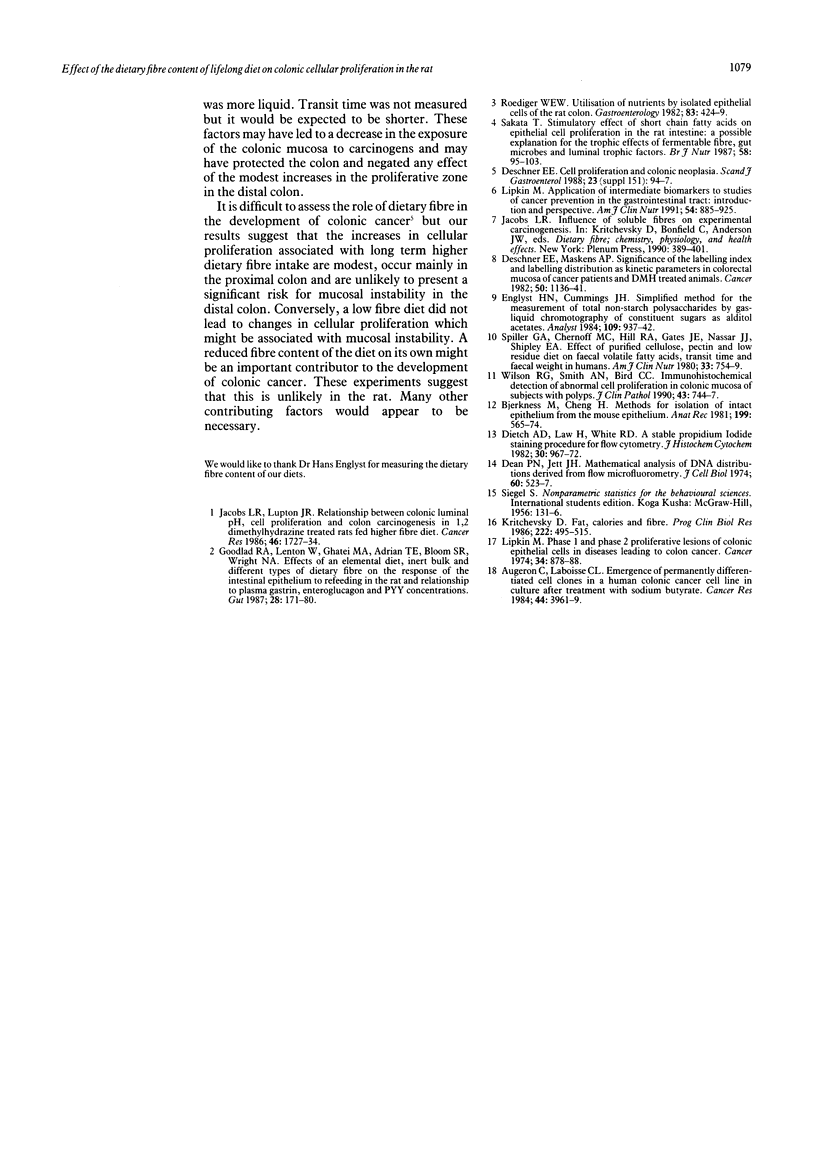Abstract
The effect of the fibre content of lifelong (18 months) diets on proximal and distal colonic cellular proliferation and short chain fatty acid (SCFA) content was investigated in 40 rats. Rats were fed a low fibre diet (17 g/kg non-starch polysaccharides NSP) or the stock diet (133 g/kg NSP). The higher fibre fed rats had increased caecal and colonic total contents (p < 0.001) and SCFAs than the low fibre fed rats (caecal SCFAs: higher fibre rats 96.4 (6.8) mumol/g wet weight v low fibre 22.7 (3.0): p < 0.001, colonic SCFAs: higher fibre 52.3 (3.1) mumol/g wet weight v low fibre 6.9 (2.2) mumol/g wet weight: p < 0.001). Cellular proliferation was increased in the proximal colon (bromodeoxyuridine labelling index, higher fibre 9.3 v low fibre 8.4 p < 0.05; flow cytometry, % cells in S phase higher fibre diet 7.9 v low fibre 6.9; p < 0.01) and there was a shift of proliferating cells to a higher region in each crypt. There was no significant difference in the percentage of cells in S phase in the distal colon of rats in both diet groups. The proliferative zone, however, was expanded in the distal colon of the higher fibre diet fed rats. This study indicates that long term higher fibre intake in rats is associated with a modest increase in cellular proliferation in the proximal colon but not the distal colon.
Full text
PDF



Selected References
These references are in PubMed. This may not be the complete list of references from this article.
- Augeron C., Laboisse C. L. Emergence of permanently differentiated cell clones in a human colonic cancer cell line in culture after treatment with sodium butyrate. Cancer Res. 1984 Sep;44(9):3961–3969. [PubMed] [Google Scholar]
- Bjerknes M., Cheng H. Methods for the isolation of intact epithelium from the mouse intestine. Anat Rec. 1981 Apr;199(4):565–574. doi: 10.1002/ar.1091990412. [DOI] [PubMed] [Google Scholar]
- Dean P. N., Jett J. H. Mathematical analysis of DNA distributions derived from flow microfluorometry. J Cell Biol. 1974 Feb;60(2):523–527. doi: 10.1083/jcb.60.2.523. [DOI] [PMC free article] [PubMed] [Google Scholar]
- Deitch A. D., Law H., deVere White R. A stable propidium iodide staining procedure for flow cytometry. J Histochem Cytochem. 1982 Sep;30(9):967–972. doi: 10.1177/30.9.6182188. [DOI] [PubMed] [Google Scholar]
- Deschner E. E., Maskens A. P. Significance of the labeling index and labeling distribution as kinetic parameters in colorectal mucosa of cancer patients and DMH treated animals. Cancer. 1982 Sep 15;50(6):1136–1141. doi: 10.1002/1097-0142(19820915)50:6<1136::aid-cncr2820500617>3.0.co;2-a. [DOI] [PubMed] [Google Scholar]
- Goodlad R. A., Lenton W., Ghatei M. A., Adrian T. E., Bloom S. R., Wright N. A. Effects of an elemental diet, inert bulk and different types of dietary fibre on the response of the intestinal epithelium to refeeding in the rat and relationship to plasma gastrin, enteroglucagon, and PYY concentrations. Gut. 1987 Feb;28(2):171–180. doi: 10.1136/gut.28.2.171. [DOI] [PMC free article] [PubMed] [Google Scholar]
- Jacobs L. R., Lupton J. R. Relationship between colonic luminal pH, cell proliferation, and colon carcinogenesis in 1,2-dimethylhydrazine treated rats fed high fiber diets. Cancer Res. 1986 Apr;46(4 Pt 1):1727–1734. [PubMed] [Google Scholar]
- Kritchevsky D. Fat, calories and fiber. Prog Clin Biol Res. 1986;222:495–515. [PubMed] [Google Scholar]
- Lipkin M. Phase 1 and phase 2 proliferative lesions of colonic epithelial cells in diseases leading to colonic cancer. Cancer. 1974 Sep;34(3):suppl–suppl:888. doi: 10.1002/1097-0142(197409)34:3+<878::aid-cncr2820340715>3.0.co;2-r. [DOI] [PubMed] [Google Scholar]
- Roediger W. E. Utilization of nutrients by isolated epithelial cells of the rat colon. Gastroenterology. 1982 Aug;83(2):424–429. [PubMed] [Google Scholar]
- Sakata T. Stimulatory effect of short-chain fatty acids on epithelial cell proliferation in the rat intestine: a possible explanation for trophic effects of fermentable fibre, gut microbes and luminal trophic factors. Br J Nutr. 1987 Jul;58(1):95–103. doi: 10.1079/bjn19870073. [DOI] [PubMed] [Google Scholar]
- Spiller G. A., Chernoff M. C., Hill R. A., Gates J. E., Nassar J. J., Shipley E. A. Effect of purified cellulose, pectin, and a low-residue diet on fecal volatile fatty acids, transit time, and fecal weight in humans. Am J Clin Nutr. 1980 Apr;33(4):754–759. doi: 10.1093/ajcn/33.4.754. [DOI] [PubMed] [Google Scholar]
- Wilson R. G., Smith A. N., Bird C. C. Immunohistochemical detection of abnormal cell proliferation in colonic mucosa of subjects with polyps. J Clin Pathol. 1990 Sep;43(9):744–747. doi: 10.1136/jcp.43.9.744. [DOI] [PMC free article] [PubMed] [Google Scholar]


